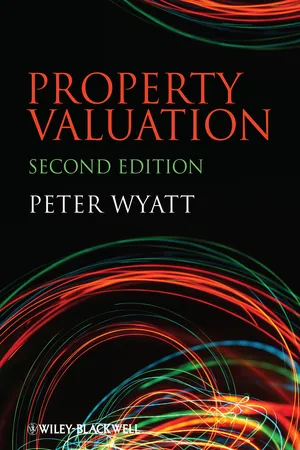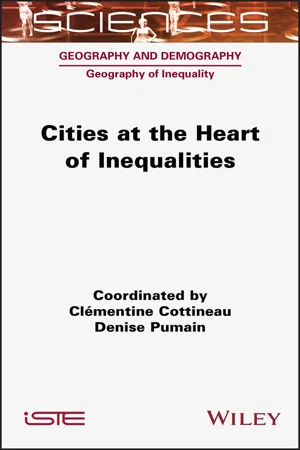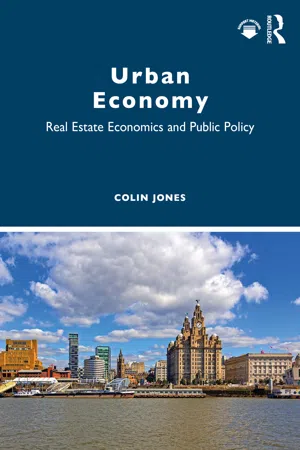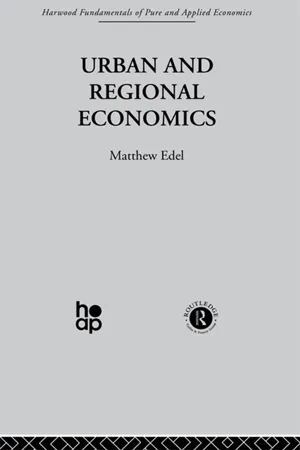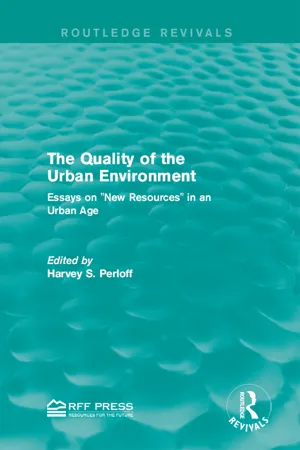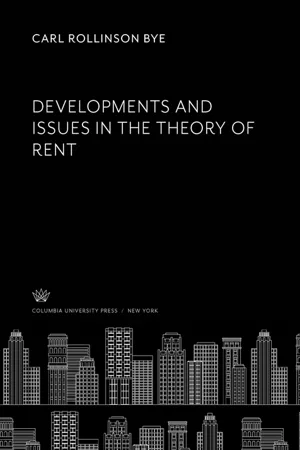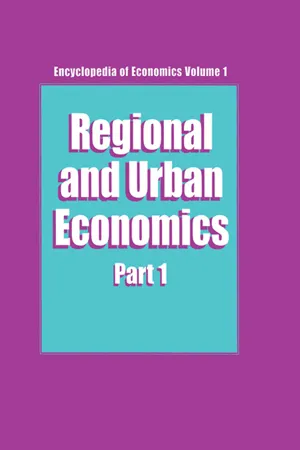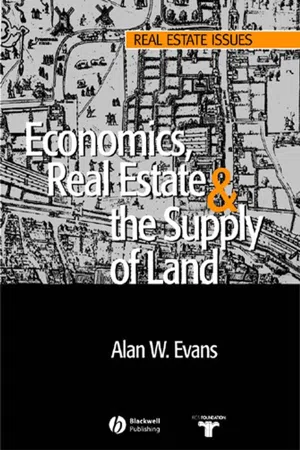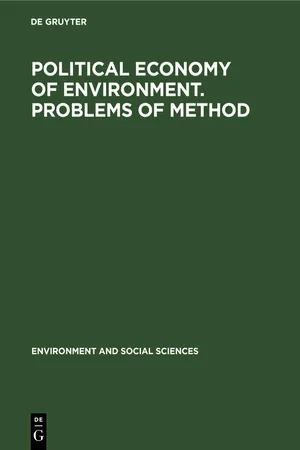Geography
Bid Rent Theory
The Bid Rent Theory explains how the price of land for different uses varies with distance from the central business district (CBD) in urban areas. It suggests that land closer to the CBD commands higher rents due to its accessibility and proximity to economic activities, while land further away has lower rents. This theory helps to understand urban land use patterns and the spatial organization of cities.
Written by Perlego with AI-assistance
Related key terms
1 of 5
12 Key excerpts on "Bid Rent Theory"
- eBook - ePub
- Peter Wyatt(Author)
- 2013(Publication Date)
- Wiley-Blackwell(Publisher)
So, according to Geltner et al. (2007), equilibrium in a well-functioning land market is attained when aggregate transport costs are minimised and aggregate land value is maximised. Bid-rents represent the maximum land rent that a user would be willing to pay for a location and a bid-rent curve shows how the bid-rent from a user falls as distance from some central point increases. This central point is the point at which costs are minimised / value maximised for a given use, each of which has its own bid-rent curve (and central point). The classical economic theories of urban rent and land use have been criticised primarily due to their simplifying assumptions and the increasing influence of modern working practices and living habits on the way urban land use is organised. These criticisms are summarised as follows:The process of allocating a land use to a site is constrained by inertia (preventing a high proportion of urban land that is in sub-optimal use from coming on to the market) and high mobility costs (preventing users from relocating) (Richardson, 1971).A change in the distribution or level of income or a change in the spatial pattern of consumer demand will cause a change in urban land values and the pattern of uses.A change in transport costs will have a greater effect on those uses that depend more heavily on transport.The theories have no regard for land use interdependence, sometimes referred to as complementarity between neighbouring land uses. - eBook - ePub
Urban Land Rent
Singapore as a Property State
- Anne Haila(Author)
- 2015(Publication Date)
- Wiley-Blackwell(Publisher)
The Housing Question in 1887 as the first important application of land rent theory in the urban context. Engels argued that if workers own their little houses, the sum saved on rent allows employers to pay lower wages. This is the same argument as that presented by industrialists in the British Parliament during the Corn Laws debate: the cheap price of grain gave capitalists an opportunity to pay lower wages (see p. 49). The same argument has also been used to explain the lower wages that transnational companies locating to Singapore need to pay thanks to state-subsidised public housing (see p. 16 and a more detailed discussion in Chapter 5).Starting with Thünen and his agricultural rent theory, urban economists have developed the theory of land rent as the theory of urban land market equilibrium, introducing two concepts of rent: the concept of bid rent (based on users' rent-paying ability and utility, and expressing the ‘willingness’ of firms, households and farmers to pay for land in different locations), and the concept of market rent (that is the highest bid). The market mechanism is assumed to allocate land to different users. One basic assumption of urban economic models has been that the residential rent gradient is negative; that is, rents decrease with distance from the city centre. Several empirical studies have attempted to show a negative rent–distance function. However, empirical research has neither verified nor disproved this. The assumption of a declining rent gradient resists refutation. When empirical research found that rents increase with distance, this was explained by referring to quality of the environment and the neighbourhood (Richardson et al. 1974; Richardson 1977: 239).Urban scholars have been divided as to the question of land rent. Mark Gottdiener (1985: 193–194) regarded theories of rent and location as providing ‘only limited ways of understanding the articulation of capital and space’, seeing it as ‘more fruitful to study the role of the secondary circuit and its array of institutions and individuals involved in the turnover of real estate for profit than it is to analyse ground rent within an urban context using nineteenth-century concepts derived from agricultural production’. Bandyopadhyay (1982: 177), on the other hand, preferred David Harvey over Manuel Castells ‘because of his focus on two basic problems in urban analysis; the necessary unification of spatial and social relations with land and its material base, and the inescapable analytic priority of a rational theory of rent and land-values’. David Harvey is of course the rent theorist par excellence. He has constantly returned to the rent question. In Social Justice and the City, Harvey (1973) connected rent to three aspects of space (absolute, relative and relational) and subsequently (Harvey 1974; Harvey and Chatterjee 1974) used rent theory in empirical analysis of the Baltimore housing market, paying attention to the role of financial institutions in creating conditions for monopoly rents. In The Limits to Capital, Harvey (1982) introduced the ideas of land as a financial asset and fictitious capital (a claim over future revenue), and in Spaces of Capital - eBook - ePub
- Clementine Cottineau, Denise Pumain(Authors)
- 2022(Publication Date)
- Wiley-ISTE(Publisher)
The notion of the urban field covers this “curvature of space” that Jean Reynaud imagined as early as 1841 in his article “Cities” in the New Encyclopedia, which “values places unequally according to the advantages of location that they provide in relation to the potential for social interaction that the city and its centrality represent” (Pumain 2006, p. 33). Geographical theory explains this form by the history of cities, which is that of a spatial extension of centrality, by diffusion from one area to another around an initial core. Economic theory proposes an explanation of this form by the competition for the occupation of central locations, which are the most accessible and the scarcest. We recall in section 2.1.2 the contribution of rent theories to the explanation of this universal model. In section 2.2, we discover the observed measures and variations of this model, before resorting in section 2.3 to complementary geographical and sociological theories to give a more complete and complex interpretation. 2.2.2. Rent theories A naive explanation for the higher monetary value of city centers is the geometric configuration of cities, the simplest schematic form of which is that of a crossroads located in a circle. In the center of the circle, the surface area is smaller than in the peripheral rings, the number of locations located near the two main roads is smaller in the center, and this scarcity of the most accessible locations explains why prices are higher in the center. This economic principle of high prices due to scarcity (“what is rare is expensive”) is, however, only a narrow geometric vision of what makes centrality attractive. Certainly, the geometric constraint is part of the explanation - eBook - ePub
Urban Economy
Real Estate Economics and Public Policy
- Colin Jones(Author)
- 2021(Publication Date)
- Routledge(Publisher)
The goal of the chapter has been to understand the spatial structure of towns and cities drawing on simplifying theories or models. It began with a focus on the values of farming land as a building block to help ultimately understand cities.Theories of agricultural rent determination were developed by Ricardo and von Thünen at the beginning of the 1800s. Ricardo’s theory focuses on the role of fertility assuming that the other characteristics of land are constant. He demonstrates how market dynamics lead to farmers’ rents reflecting the relative differences in fertility.von Thünen assumes fertility is constant and instead lets transportation costs vary with distance from a market town. Applying the same competitive bidding process based on farmers’ profits at a given location brings a negative rent gradient from the market town.These models treat rent as a ‘surplus’. It is the amount available to pay the rent on each farm after taking into account revenues and costs, plus acceptable or ‘normal’ profits. This surplus mechanism is also the basis by which urban land users determine the rent they are prepared to pay.Understanding of urban spatial structure is given by a model developed by Alonso that is based on a hypothetical city which includes a featureless plain and a free market in land. Accessibility is key to determining land values in the city, and this is maximised at the centre.Alonso saw revenue as generally maximised at the city centre and then fell away, while costs are lowest at the centre and increase with distance away from the centre. Given this pattern of revenue and costs, bid rent curves, and hence rents, within Alonso’s model, are highest at the centre and decline with distance.However, the need for and role of accessibility will vary by land use sectors, and hence so do the precise spatial patterns of revenue and costs. As a result, different sectors have distinct slopes to their bid rent gradients. Retailers on average have steep bid rent curves as they depend on passing trade that is highest at accessible central locations. - eBook - ePub
- Rubén Cordera, Ángel Ibeas, Luigi dell'Olio, Borja Alonso, Luigi dell’Olio(Authors)
- 2017(Publication Date)
- CRC Press(Publisher)
Table 4.3 presents an example of location choice made by a household with an income of €2000. The household is able to locate in the furthest zone from the CBD with the same level of utility, and the greater transport and consumer costs are compensated by having more land. Another possibility is to choose somewhere closer to the CBD with lower transport costs but with the implication of a higher rent. In this case, in order to maintain the level of utility, the household can obtain less land, and use the remaining income to consume other goods. Therefore, the household will find location equilibrium in both zones as they will both provide an identical level of utility.TABLE 4.3Rent Offered by a Household at Different Distances from the CBD for the Same Level of Utility4.2.2 CALCULATING THE DISTRIBUTION OF LAND USE AND RENTS FOR URBAN LANDIn the case where there are various kinds of users, the slopes of the curves representing the bid rent will vary for each of them due to their different preferences in relation to the transport costs and their substitution for z and l. For example, a user or a company with a high preference for locating in the centre will show a bid–rent curve with a steeper slope. If all the location choices of all the companies and households are seen at the same time, it becomes possible to do it without an effective rent function as provided in the previous case and substitute it by the envelope of the bid–rent curves of all the agents seeking to locate. Alonso proposed a solution algorithm which, starting at the CBD, located the different urban agents from higher to lower in accordance with the bid–rent slope functions. Once the last user was located, the land rent just outside the limits of the urban area corresponded to the price for agricultural land (Figure 4.3 ).In a similar way to the von Thünen model, the land uses will show a concentric spatial pattern around the CBD. Each location will be occupied by the user who offered the highest rent and the different types of activities and households will have indifference in the localization within each concentric area. Furthermore, the location will be stable because the spatial pattern is optimal considering the preferences and financial constraints of the agents. - eBook - ePub
Urban and Regional Economics
Marxist Perspectives
- M. Edel(Author)
- 2013(Publication Date)
- Taylor & Francis(Publisher)
*Rent theory can be used to suggest theoretical reasons why urban renewal may assist accumulation, and perhaps to measure its effects. Lojkine suggests that small properties may exert a barrier to accumulation, preventing assembly of large enough tracts for modern construction [235 ]. But the extent to which this is dependent on building technologies and really affects productivity is an open question. Watkins suggests that older cities have out-of-date facilities, in terms of physical infrastructure and the co-location of different economic sectors, so that major redevelopment may be required for using the highest productivity technologies [400 , 293 ]. (The argument is related to Gordon’s stages of urban development [147 ].) Harvey makes the more general point that capital loses flexibility when it takes the form of fixed capital and a built environment [183 ]. Change in land uses is, therefore, a major problem. The possibility of redevelopment without massive State intervention is, however, suggested by recent studies of ‘gentrification’ the displacement of lower income by higher income residents [130 , 218 , 419 ]. These adaptations suggest Harvey’s position on the fixity of fixed capital may be overstated.Whatever the need for State intervention to facilitate new land uses, these uses could not exist without demand arising from cities’ changing roles (see Section 3). Hymer suggested that the concentration of capital is concentrating demand for land in a reduced group of key cities [202 ]. This demand allows rent to be realized by landowners, if they can transfer their property to uses wanted by financial-corporate capitalists. In the US, land values are higher in larger than in smaller cities, and greater for cities with corporate headquarters than for those with purely industrial roles [95 , 404 - eBook - ePub
The Quality of the Urban Environment
Essays on "New Resources" in an Urban Age
- Harvey S. Perloff(Author)
- 2015(Publication Date)
- Routledge(Publisher)
These basic ideas are now well understood by economists. And the process of sorting them out has been a notable accomplishment in the development of economic doctrine. By themselves, they do not, of course, provide us with a model of urban land values. For that purpose it is necessary to incorporate land rents into a model that describes the demand and supply of urban land for all uses. The crucial characteristic of urban land is the great complexity resulting from the fact that supply and demand for different parcels of land are related in significant and poorly understood ways. In other words, an urban economy is a complicated general equilibrium system. Understanding the relationships among the various sectors of the urban economy is the key to better understanding and better public decision making in urban areas. For example, an increase in property taxes in the central city relative to those in the suburbs will affect the locational advantages and presumably the land rents in the two sectors. As a second example, improved radial transportation will alter the relative advantages of locations at different distances from the city and will presumably affect land values. In both examples, major public policy issues depend on the effect of public actions on land uses and land values. Such effects can only be evaluated within a general equilibrium model. The models discussed in the remainder of this paper constitute a beginning at thinking about urban problems in a general equilibrium context. Although none of the models is sufficiently detailed to evaluate the kinds of policies that are discussed in other papers in this volume, they indicate a promising direction for future research.Land Rents in Recent Models of the Urban EconomyWe saw above that two basic ideas have dominated the historical development of land rent doctrine. First, the equilibrium rent of a piece of land should just absorb whatever revenues are left over after other inputs have been paid at whatever prices the market dictates. Second, land rents should guide the allocation of land: in competitive markets, the value of the marginal product of any use of land should just equal the land’s rent. We also saw that the culmination of the long period of development of production theory was the demonstration that these two basic ideas are consistent if all input and output markets are competitive and if production functions display constant returns to scale (or, to use Wicksell’s generalization, if markets are competitive and the production function yields a well-defined minimum to the average total cost curve). Although these conditions are important both theoretically and empirically, they are clearly not the only conditions in which economists should be interested. Whether any other set of conditions exists in which land rents can play both roles is an open question. - eBook - PDF
- J. Vernon Henderson, Edwin S. Mills(Authors)
- 2014(Publication Date)
- Academic Press(Publisher)
This contradicts either or both the assumptions that utility and profits are always maximized in equilibrium and that land and housing are normal economic goods. If we suppose that the rent gradient falls, the foregoing inconsistencies are even more pronounced. Therefore, the rent gradient must shift up with population and hence the city area will expand. 2. Using the same type of argument, it is possible to show the following: dwi/dp/(Mi) < 0, the normal own-price effect on factor demand; du i /dy > 0, the normal income effect on derived demand for a factor; du l /du 0 > 0, or, ceteris paribus, the whole urban area expands if the CBD expands. 3. du l /dp k % 0. If the price of capital rises, it is unclear what happens to the 24 l. SPATIAL EQUILIBRIUM AND CHARACTERISTICS OF A SIMPLE CITY demand for land. While the demand for land relative to capital rises, the relative consumer demand for housing and both factors falls, since housing is now more costly to produce and purchase. 4. du l /dt < 0. This indicates that increased cost of access to the CBD causes people to crowd closer to the CBD. If t rises, people farthest from the CBD, say at u u have a greater absolute increase in commuting time than people nearer the CBD because they travel greater distances. Therefore people nearer the CBD relative to those farther away must experience an increase in land rents to offset their increased relative access advantage. This maintains a stable spatial equilibrium between those near the CBD and those farther away. This upward rotation in the rent gradient will reduce demand for land everywhere. 14 Hence u^ will decline. The urban demand curve for argricultural land is illustrated in Fig-ure 1.5. The supply curve of agricultural land is also pictured and an equilib-rium illustrated. Although the supply of land is drawn as infinitely elastic at p^UiX it could be upward sloping. - Carl Rollinson Bye(Author)
- 2019(Publication Date)
- Columbia University Press(Publisher)
Rent Dependent upon a Scarcity of Desirable Land. Greater realism is given to the study of rent by recog-nizing its dependence upon a scarcity of the most de-9 Chamberlin, The Theory of Monopolistic Competition, p. 113. 10 Ibid., pp. 2i4ff. 1 1 Hobson, The Industrial System, p. 104. D E V E L O P M E N T S I N T H E T H E O R Y 13 sirable lands. If such lands were sufficiently abundant, the supply of products would be limited only by the scarcity of non-land factors, and equilibrium prices would afford no land rent. When an extension of pro-duction, in response to growing demand, is impeded by a dearth of the best lands, prices must rise and rent will grow. The existence of this rent does not depend at all upon the existence of worse land, but, on the contrary, it is even reduced thereby. 12 Not All Rent Covered by Comparison with Extensive Margin. A further examination of the relationship be-tween a scarcity of land and its rent was induced by the observance of several possible instances of rent not cov-ered by a comparison with productivity of inferior land. The first of these cases is built upon the fiction that all land is of the same grade. Under this assumption, all of it would command a rent if the quantity of land were limited in relation to demand for its products, and if the intensity of use were extended beyond the appearance of diminishing returns. 13 Clearly, then, in abstract principle rent does not depend upon variations in productivity of different land areas. However, it is possible to illustrate the point without recourse to hypothetical assumptions. Although marginal rents can be interpreted as differentials by a roundabout and strained method of reasoning, they are essentially scarcity rents and are distinguishable even on relatively valuable lands. The least desirable land for urban build-ing sites often will bring a good price for truck gar-12 Cassel, The Theory of Social Economy, I (Book 2), 287. 13 Carver, The Distribution of Wealth, p. 194.- eBook - ePub
- Richard J. Arnott(Author)
- 2013(Publication Date)
- Routledge(Publisher)
r on that line. Then, without any change, all the previous results also apply for this case.E. Multicentric cities. Although we have assumed a single concentration of employment and shopping, the CBD, many works have introduced multiple, prespecified centers of employment or shopping. See, for example, Muth [93], Papageorgiou and Casetti [105], Hartwick and Hartwick [55], Odland [96], White [153], and Romanos [117].2. RESIDENTIAL LAND USE WITH EXTERNALITIES
In this section, we introduce externalities into the basic theory of residential land use. Our focus is on the spatial aspects of externalities, since other aspects receive in-depth treatment elsewhere.34 The basic model (1.1 ) is now generalized as follows:where E(r) represent the level of externalities at distance r from the CBD,35 and G(r) is the tax per household at r. We may call (2.1 ) the extenality model of residential choice. The bid rent functionbecomeswhere Z(r, u, E(r)) is the solution of U(z, s, E(r)) = u for z.E(r) represents externalities from public facilities in subsection 2.1 , and neighborhood externalities in subsection 2.2 . In subsection 2.3 , transport cost is subject to traffic congestion with E(r) being omitted.2.1. Local public goods and location of public facilities
The famous paper by Tiebout [145] marks the beginning of abundant studies of the efficient provision of local public goods (among communities). To a great extent these studies have ignored the spatial dimension in modeling local public goods. Here, we shall focus on studies which do consider the spatial dimension and land market. Such studies fall into 3 groups which are differentiated in accordance with the spatial distribution of public goods. - Alan W. Evans(Author)
- 2008(Publication Date)
- Wiley-Blackwell(Publisher)
Of course in addition, and necessarily associated with the extension of the area, rents over the area which is already being cultivated will increase and that land will be used more intensively. 0 R S Distance Figure 3.1 Chapter Three 33 The model can be varied. We have demonstrated the concept using the Von Thunen model applied to agricultural land. Alternatively the modem, Alonso, version of the model can be applied to urban land alone in which case extension at the margin becomes an increase in the size of the built up area as employment at the centre increases. Even as regards agricultural land most of the classical economists thought in terms of differences in fertility rather than distance from the market. Figure 3.1 can be thought of as representing this if fertility were measured along the horizontal axis, instead of distance, with the degree of fertility highest at the left and lowest at the right. The least fertile land is not cul- tivated, whilst the most fertile is. An increase in the demand for the agri- cultural product, because of increased population or increased incomes, will lead to increased rents and a shift in the rent gradient from AR to BS. In the figure RS therefore indicates the previously uncultivated, less fertile, ‘marginal’ land which is now brought into cultivation. We have already analysed the neoclassical extensive margin in the previous chapter and need not repeat that analysis here in detail. What was shown there, in Figure 2.3, is that an increase in the demand for one product, in that case potatoes, will lead to land being bid away from other uses, in that figure corn was the alternative use. As the increased demand for potatoes leads to the price of potatoes being higher, the increased price means that, initially, higher rents can be paid in that use than in any alternative. As land is bid away from the alternative, less profitable, uses, the price of land in those other uses increases since they have to pay competitive rents.- eBook - PDF
Political economy of environment. Problems of method
Papers presented at the Symposium held at the Maisons des Sciences de l'Homme, Paris, 5–8 July, 1971
- (Author)
- 2019(Publication Date)
- De Gruyter Mouton(Publisher)
Nonetheless, some historical and statistical evidence, as well as theoretical considerations, do point in the direction of regressive distribution among metropolitan property owners. The pattern of land value changes that occur with urbanization may be infer-red from the comparison of cities of different sizes. As a city grows larger, over some range at least, its aggregate land values increase. If the city does not achieve corporate-city and then world-city status, however, the growth of values will eventually taper off at least relative to other cities. Even with total values advancing, the growth is a result of offsetting economies and dis-economies of size. There is no necessity for the effects of both to be felt evenly at all points within the city. Indeed, cross-section studies of land values and uses within a city typically show that values are highest in the center of a city, and descend toward the periphery. The gradient is not always monotonic, as Frieden (1964) shows. Changes in values at different points of time may be different at different locations. Higher land values downtown are related to the advantages of accessibility to the center of gravity of business. Particularly in corporate cities, where face to face contact between representatives of different businesses, and within-building contact between many functionaries, is necessary, space in a central business district is at a premium. Port and railhead proximity may have, in the past, created a similar premium on central space for manufacturing and warehouse functions, but this has been less true since the rise of the truck as a primary means of freight transport. Housing space near business and industrial centers is also at a premium, since it allows a saving in commuting costs. Typically, this saving attracts the low paid employee, who is forced by income constraints to accept high density residence, in order to save on transport.
Index pages curate the most relevant extracts from our library of academic textbooks. They’ve been created using an in-house natural language model (NLM), each adding context and meaning to key research topics.
